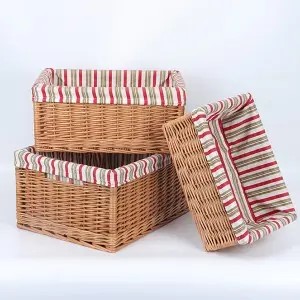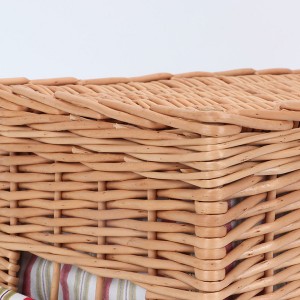

Wicker baskets, known for their natural, eco-friendly materials and exquisite craftsmanship, have become a popular choice for home storage and decoration. Our Lucky Weaving wicker products are particularly popular with consumers thanks to their carefully selected natural materials, dense weaving techniques, and personalized designs (such as leather handles and removable linings). However, improper care of natural willow can lead to mold, deformation, and insect damage, which not only affects its appearance but also shortens its lifespan. This article, based on product characteristics, provides a professional and practical care plan for wicker baskets, covering cleaning methods, daily maintenance, and scenario-based care, to help you preserve their natural texture and handcrafted warmth.
1. Cleaning: Follow the principle of "minimum water use, maximum material preservation," tailored to the brand's materials and design.
Wicker products are often made of carefully selected natural willow and rattan strips, with some styles featuring special features such as leather handles and plaid linings. When cleaning, it's important to balance cleanliness requirements with material protection to avoid damaging the natural fibers and the detailed craftsmanship. The key principles are: avoid soaking, use minimal water, and separate the baskets.
1. Basic Cleaning: Grade the cleaning process based on the severity of the soiling to protect the natural material.
Natural wicker fibers can soften and warp easily when exposed to water. Choose the appropriate cleaning method based on the severity of the soiling, avoiding over-cleaning that could damage the dense weave.
• Light Cleaning (Daily Dust/Debris): Suitable for removing dust, biscuit crumbs, and other debris from daily use. No water is required. First, gently scrub with a soft-bristled brush (such as a dusting brush or an old toothbrush) along the wicker weave. Use a cotton swab to get deeper into the crevices (Lucky Weave products have a dense weave, so dust easily accumulates in the crevices, requiring patience). For further dust removal, turn the basket upside down and gently tap the bottom to loosen loose debris. Finally, wipe the entire basket with a dry microfiber cloth to remove any remaining dust.
• Medium Cleaning (Oil/Food Residue): For Lucky Weave picnic baskets and kitchen storage baskets, which are often used for food storage, if light oil or food residue is present, control the amount of water and detergent used. First, follow the light cleaning steps to remove loose dust. Then, dilute a neutral dishwashing liquid with warm water (concentration ≤ 1:50; avoid using strong alkaline soaps or scouring powders). Dip a soft cloth into the diluted lather (do not soak the basket directly in water) and gently scrub the stain along the grain. Repeat 2-3 times for heavily greasy areas. Wipe away any remaining lather with a clean, damp cloth wrung out until dry. Immediately blot the surface with a dry cloth to prevent moisture from penetrating the wicker wicker.
• Heavy Cleaning (Stubborn Stains/Mold): For stubborn greasy stains or mildew caused by the rainy season, treat gently to protect the natural color of the material. For stubborn grease stains, mix baking soda with a small amount of warm water to form a paste. Apply to the stain and gently scrub with a soft brush (baking soda absorbs grease and is gentle, avoiding damage to the wicker). Finish with a moderate cleaning regimen. For mildew stains, first use a soft brush to remove the surface mildew (to prevent the spread of the mold). Then, wipe the area with a mixture of white vinegar and warm water (1:3). Let it sit for 5 minutes, then wipe it clean with a damp cloth. Finally, pat dry thoroughly with a dry cloth and air dry in a cool, well-ventilated place.
• Removable Lining: The lining included with some Lucky Weave storage baskets and picnic baskets should be removed and washed separately. After checking the product label to confirm washability, hand wash on a gentle cycle using warm water below 30°C with a mild detergent. Avoid machine washing and tumbling (to prevent the lining from warping and affecting the fit of the basket). After drying, lay the lining flat inside the basket to avoid wrinkles that could cause uneven stress on the wicker wicker and ruin the overall shape. II. Maintenance: Focus on "moisture-proofing, pressure-proofing, and insect-proofing" to extend the lifespan of brand products.
Through scientific maintenance, we can avoid the three major risks of "moisture-induced mold, deformation due to heavy objects, and insect infestation and rot," while also ensuring that our products maintain their exquisite craftsmanship and quality over time.
1. Moisture-proofing: Preventing mold growth at the source
Natural wicker is susceptible to mold in humid environments, especially for woven outdoor items (such as bicycle baskets) and kitchen baskets. Moisture-proofing is essential.
• Environmental Avoidance: Avoid placing baskets in humid areas, such as under kitchen sinks and bathrooms. If used outdoors (such as bicycle baskets), remove or cover with a waterproof cover to protect them from rain. During normal storage, place a waterproof silicone mat or wooden board under the basket to isolate it from ground moisture. • Active Moisture Prevention: During the rainy season or other high-humidity seasons, wipe the basket surface with a dry cloth 1-2 times a week. If necessary, place 1-2 packets of food-grade silica gel desiccant inside the basket (avoid direct contact between the desiccant and the wicker to prevent localized water loss). If accidentally stained with water, wipe it dry immediately with a dry cloth and place it in a well-ventilated area to air dry. Do not stack or store it directly.
2. Pressure Prevention: Protect the Handmade Shape and Prevent Structural Deformation
Lucky Woven Willow Baskets achieve their unique shape through hand-weaving. Long-term heavy pressure can easily cause the wicker limbs to break and the basket to collapse. Therefore, proper use and storage are essential.
• Weight Control: Natural wicker has a limited load capacity (typically 5-10 kg; refer to the product instructions for details). Do not place heavy objects (such as pots filled with water or large metal utensils) inside the basket, especially unusually shaped models like the Lucky Woven Oval Basket and the Laundry Basket, as uneven loads can increase the risk of deformation. During daily use, try to distribute heavy objects as much as possible to avoid concentrating them on the bottom or edges of the basket. • Storage Protection: Avoid stacking or squeezing empty baskets when not in use. It's recommended that empty baskets be hung individually (using wall hooks) or laid flat, with cardboard placed underneath to support their shape. If not used for an extended period, fill the basket with soft material such as newspaper or bubble wrap to maintain its original shape, then cover with a breathable cloth bag (non-breathable dust covers are not recommended to prevent moisture from trapping) for storage.
3. Mothproofing: Protect natural materials from insect damage. Natural wicker attracts moths (such as clothes moths and wood borers). Lucky Woven Storage Baskets, especially those that have stored food or have been in a dark environment for extended periods, require regular inspection and prevention.
• Regular Inspection: Check the basket monthly for insect holes and insect droppings (small black particles), focusing on the crevices and bottom of the weave. If food such as grains or dried fruit has been stored, thoroughly clean it before storage to prevent food residue from attracting pests. • Active moth prevention: Lightly spray a small amount of diluted lavender or peppermint essential oil monthly on the basket surface (away from food contact areas). (It's naturally moth-repellent and has a refreshing scent. Avoid high concentrations to avoid irritating the wicker.) When the basket is not used for extended periods, place two to three pieces of camphorwood chips inside (wrapped in breathable paper to prevent direct contact with the wicker). However, camphorwood chips should not be used in baskets containing food; dried lavender flowers can be used instead.
• Treatment for insect infestation: If minor insect holes are found, first use a toothpick to remove the insect feces. Then, use a cotton swab dipped in 75% rubbing alcohol to wipe around the holes to kill any remaining eggs. After drying, apply a thin layer of melted beeswax to the holes to prevent further infestation. If the holes are severe (more than three or deep), discontinue use to prevent further damage.
4. Regular maintenance: Restore toughness and brighten the texture
After long-term use, wicker baskets may become dry and dull. Regular maintenance can restore their natural luster and toughness. • Grease Care: Every 6-12 months, use a soft cloth dampened with a small amount of olive oil or walnut oil (do not use industrial oils) and gently rub the surface along the grain of the wicker (a thin application is sufficient to avoid grease buildup and yellowing). After treatment, let it sit for 10 minutes before wiping off any excess grease with a dry cloth. This not only replenishes the wicker's essential oils, preventing cracking, but also enhances its natural color, giving the basket a warm, patina-like feel.
• Color Protection: Natural-colored products should be kept out of direct sunlight, as this can cause the color to fade and the wicker to become brittle. For dyed products, test the corners with a damp sponge for color loss when washing for the first time. Subsequent washings should avoid contact with light-colored items to prevent staining.
Conclusion
The charm of Lucky Weave wicker baskets lies in the rusticity of the natural materials and the warmth of handcrafted craftsmanship. Mastering scientific cleaning and maintenance methods will not only extend the product's lifespan (with proper care, it can last for 3-5 years or even longer) but also allow each wicker basket to develop a unique, lived-in feel over time. The three core elements of "less water protection, moisture and pressure resistance, and regular maintenance" can allow this naturalness and craftsmanship to accompany your daily life for a long time.
Post time: Oct-25-2025





